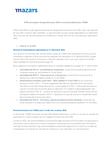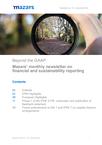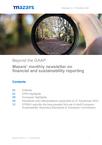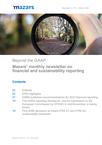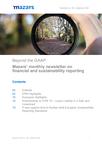
IFRS: main changes for 2022 and recommendations from ESMA
The past year has not brought many changes when it comes to IFRS, but through this newsletter, we want to offer you an overview of the new texts applicable on 31 December 2022 and ESMA's recommendations, to help you close this financial year.
1. Year-end closing on 31.12.2022
Standards and interpretations applicable on 31 December 2022
To discover the panorama of the latest texts published by the IASB (International Accounting Standards Board) with details of those that are mandatory and those that can be applied in advance on 31 December 2022, given the progress of the European adoption process to date, we invite you to read our November newsletter (page 10).
Here are the four changes that are mandatory as of 1 January 2022:
- IAS 16 Amendments – Tangible fixed assets, relating to products generated before their intended use date (issued on 14 May 2020);
- IFRS 3 Amendments – Business Combinations, regarding updated reference to the conceptual framework (issued on 14 May 2020);
- Annual Improvements (2018-2020 cycle, issued on 14 May 2020) relating to several standards: IFRS 1 - First-time Adoption of International Financial Reporting Standards relating to subsidiaries becoming first-time adopters; IFRS 9 - Financial Instruments relating to the inclusion of fees in the 10% criterion for derecognition of financial liabilities; IFRS 16 - Leases relating to the illustrative example of lease incentives; IAS 41 - Agriculture on the inclusion of taxes in fair value measurements;
- IAS 37 Amendments - Provisions, Contingent Liabilities and Contingent Assets, regarding the costs to be taken into account in determining whether a contract is unprofitable (issued on 14 May 2020).
ESMA’ recommendations for the 2022 financial statements
On 28 October, the European and Securities Market Authorities (ESMA) published on its website its common European supervisory priorities for the 2022 annual financial statements.
As in 2021, the recommendations for IFRS financial statements focus on the disclosure of climate-related matters and recall the importance of connectivity between financial and non-financial information. The recommendations also address the consequences of Russia's invasion of Ukraine and, more broadly, the current macroeconomic environment. They address the implementation of IFRS 17 (the new standard on insurance contracts) and include a few reminders about the Alternative Performance Measures (APMs) and electronic reporting (ESEF).
The common supervision priorities at the European level also include a section specifically covering non-financial reporting. These recommendations are based on three aspects: (i) climate issues, (ii) information communicated under Article 8 of the Taxonomy Regulation and (iii) cross-cutting issues of non-financial reporting, in particular, the scope of reporting and the quality of information.
The main recommendations on IFRS financial statements concern:
- Impacts of climate risks on financial reporting, including: (1) consistency between IFRS financial statements, management report and non-financial information; (2) impairment testing of non-financial assets; (3) provisions and other financial statement items; (4) power purchase agreements; (5) climate risks and financial institutions;
- The Russian invasion of Ukraine: (1) presentation of financial statement impacts; (2) control analysis; (3) classification as non-current assets (or groups) held for sale and discontinued operations; (4) impacts on insurance contracts;
- Macroeconomic environment: ESMA notes that the current macroeconomic environment, through a combination of factors (lingering effects of the pandemic, rising interest rates, geopolitical risks), represents both a source of uncertainty and a challenge for companies and their businesses. ESMA strongly urges companies to analyse and assess the impacts of the macroeconomic environment on their financial statements and to accordingly adapt the information provided in the annex on this matter. The main topics are related to: (1) impairment testing of non-financial assets; (2) employee benefits; (3) turnover; (4) financial instruments.
2. IFRS in brief
Further deliberations on the Presentation of the Financial Statements project
During the September 2022 meeting, IASB continued to re-deliberate on the proposals contained in the December 2019 General Presentation and Disclosures Exposure Draft.
Here we provide an update on the most important decisions taken this month, bearing in mind that we must wait for the publication of the final IFRS standard, expected at this stage in 2023, to have confirmation of the future standard's content. The key issues concern: unusual income and expenses, specified subtotals and the presentation of operating expenses.
Further deliberations on the Goodwill and Impairment project
During its September 2022 meeting, IASB reconsidered the preliminary positions contained in its discussion paper (which is the pre-Exposure Draft stage) Goodwill and Impairment, on improving disclosures about business combinations and made several provisional decisions.
IASB has tentatively decided to propose the addition of two new disclosure objectives to the IFRS 3 standard - Business Combinations. IASB also tentatively decided to require an entity to disclose the “strategic rationale for the combination” where it was required to disclose the “primary reasons for the business combination” (IFRS 3.B64d) and to provide quantitative information about expected synergies in the year of acquisition.
In addition, during its November 2022 meeting, IASB again discussed whether to retain the impairment model only or whether to consider reintroducing goodwill amortisation.
Without sufficient evidence to justify a change from one model to the other, the Board has tentatively decided to maintain its preliminary view that the impairment model should be retained for the subsequent recognition of goodwill. IASB will be asked during its December meeting to decide whether to move the Goodwill and Impairment project from the research phase to a standard-setting phase.
Proposed amendments to IFRS 9 on the SPPI test for debt assets: general principles, non-recourse instruments and contractually related instruments
During its September 2022 meeting, IASB continued its further deliberations on the amendments to be made to IFRS 9 as part of Phase 1 of the Post-Implementation Review (PIR) of IFRS 9.
This analysis phase, which begins in September 2021, focuses on the classification and assessment part of IFRS 9 and may lead IASB, when necessary, to propose amendments to improve the aspects of the standard identified as problematic by the various stakeholders.
In this context, IASB has tentatively decided to amend IFRS 9 to clarify the application of the "SPPI" (Solely Payments of Principal and Interests) test to debt assets. The SPPI test allows a debt asset to be classified as a basic SPPI debt instrument when its contractual cash flows consist solely of capital and interest payments. This SPPI qualification allows the entity to account for these assets at amortised cost or at fair value through recyclable equity, depending on the business model to which they relate.
In addition, during its November 2022 meeting, IASB continued its discussions on the proposed amendment to IFRS 9 as part of Phase 1 of the IFRS 9 retrospective assessment. The Board's decisions taken in November cover the following topics:
- the use of the SPPI test for contractually linked instruments ("CLI");
- the opening of an accounting option to derecognise a financial liability of an entity that transfers cash by electronic funds transfer;
- the completion of PIR IFRS 9 Phase 1.
The decisions taken by IASB on these topics are presented in our September and November 2022 newsletters.
Draft IFRS standards on sustainability-related disclosures: ISSB analysis of comments received and planning of further deliberations
During its September and December 2022 meeting, the International Sustainability Standards Board (ISSB) considered the summary of comment letters received during the public session that closed at the end of July on the draft IFRS S1 standards, General Requirements for Disclosure of Sustainability-related Financial Information and IFRS S2, Climate-related Disclosures.
Even if the Board did not have to make any decisions on the content of the standards this month, it did agree on a plan for further deliberations, to complete the initial global baseline (i.e. internationally recognised and used sustainability reporting standards) by the end of the year, to be published at the beginning of 2023.
Over 700 comment letters were sent to the ISSB on IFRS S1, slightly fewer on IFRS S2. The summary of these responses, as prepared by the technical staff, highlights several issues detailed in our September 2022 newsletter.
The Board's discussions in December 2022 led to the decisions detailed in our December 2022 newsletter.
Amendments to the IFRS 16 standard “Lease Liability in a Sale and Leaseback”
On 22 September, IASB published amendments to IFRS 16 "Lease Liability in a Sale and Leaseback". These amendments provide clarification on the subsequent assessment of sale and leaseback transactions where the initial sale of the underlying asset meets the criteria in IFRS 15 to be accounted for as a sale. In particular, the amendments clarify how to subsequently assess the lease liability arising from such transactions when there are variable lease payments that are not dependent on an index or rate.
Taking into account the comments received on its draft, IASB does not provide any clarification on how to assess the proportion of the seller-lessee's interest in the asset, contrary to the position taken in the exposure draft. In practice, an entity will therefore have to determine for itself how to assess the retained right of use, so that no gain or loss related to the retained right of use is recognised (the approach proposed in the June 2020 IFRS IC decision agenda being only one possible way).
The amendments are therefore limited to adjusting the existing sale and leaseback requirements to allow variable payments that are not dependent on an index or rate to be included in the subsequent assessment of the lease liability (in a manner that is consistent with how the entity determined the proportion of the retained interest in the asset and how it initially assessed the lease liability).
IASB has set the effective date of these amendments for annual periods beginning on or after 1 January 2024. Earlier implementation is possible.
IASB issues limited amendments to IAS 1 on the classification of liabilities with covenants
On 31 October 2022, IASB published amendments to IAS 1 entitled "Non-current Liabilities with Covenants", which specifically address how covenants should be taken into account in the classification of a liability as current or non-current.
These amendments clarify that only those covenants with which an entity is required to comply by the balance sheet date affect the classification of a liability as current/non-current. This classification is therefore not affected when the right to defer settlement of that debt by at least 12 months depends on compliance with covenants at a date after the balance sheet date.
These amendments also clarify the disclosures about the nature of the covenants, so that users of financial statements can assess the risk that non-current debt with covenants becomes repayable within 12 months.
IASB has set the effective date of these amendments for annual periods beginning on or after 1 January 2024, with the possibility of an earlier application. They are to be applied retrospectively, in accordance with IAS 8.
These amendments will now have to follow the European adoption process, as no date for their adoption by the European Union has been announced at this stage.
IFRS IC Agenda Decision on accounting for lease concessions at the lessor
Following IASB's non-objection in October, the IFRS IC has issued an Agenda Decision (see addendum to the September IFRIC Update) dealing with the accounting for leasehold concessions granted by the lessor in connection with the application of IFRS 9 and IFRS 16.
This final decision follows a question submitted to the IFRS IC in the context of a lease concession that modifies the terms and conditions of a contract, qualified as an operating lease by the lessor.
Given this situation, the IFRS IC was asked to clarify:
- how the lessor should have applied the expected credit loss model in IFRS 9 to the operating lease receivable, before the lease concession was granted, if the lessor planned to waive the payments due from the lessee; and
- whether the lessor should apply the derecognition provisions of IFRS 9 or the contract amendment provisions of IFRS 16 to account for the lease concession.
To the first question, the IFRS IC answers that:
- in accordance with paragraph 2.1(b)(i) of IFRS 9, the lessor is required to apply the impairment requirements to an operating lease receivable from the date it recognises that receivable; and
- in accordance with paragraph 5.5.17 of IFRS 9, prior to granting the lease, the lessor assesses the expected credit losses on its operating lease receivable in a manner that reflects an “objective and probability-weighted amount”, the “time value of money” and “reasonable and supportable information”, and that this assessment takes into account, among other things, the expected lease waivers that the lessor expects to grant to its lessee.
To the second question, the IFRS IC answers that the lessor accounts for the lease concession by applying:
- the derecognition requirements of IFRS 9 (paragraphs 2.1(b)(i) and 3.2.3(a)) to the discontinued lease payments that are included in the operating lease receivable, upon the date the lease concession is granted; and
- the provisions on contract modifications in IFRS 16 (paragraphs 81 and 87), on discontinued lease payments that were not included in the operating lease receivable (because they were not yet contractually due), to the extent that this meets the definition of a lease modification under IFRS 16 (i.e. a change in the lease price that was not part of the original terms and conditions of the lease).
As a conclusion to this final decision, the IFRS IC states that the requirements of the existing standards are sufficient to answer the questions raised, and indicates that it has taken the decision not to add a new standard-setting project to IASB's work schedule.
Agenda Decision of the IFRS IC on the IFRS 17 treatment of multi-currency insurance contracts
IASB approved in October 2022 the decision taken in September by the IFRS IC (see addendum to the September 2022 IFRIC Update) on the absence of a requirement for a group of multi-currency insurance contracts to be split into sub-groups to account for foreign currency risk and on the interaction between IFRS 17 and IAS 21 for such contracts.
IFRS 17.14 requires subgroups of contracts with similar risks that are managed together to be separated within a portfolio. The IFRS IC has found that while foreign exchange risk is indeed one of many risks to be considered, “similar” risks should be considered, not “identical” risks. In other words, a portfolio could include multi-currency contracts and the analysis of the nature and extent of similarities is a matter of judgment.
For the assessment of multi-currency contracts, IFRS IC recognises that one or more currencies may be used. In the latter case, the IFRS IC recalled that (i) under IFRS 17.30, a group of contracts, including its contractual service margin (CSM), is a “monetary” item for the purposes of IAS 21, and furthermore, (ii) the CSM is a single margin of the contracts: there are therefore not multiple CSMs depending on the currency of the underlying flows. Therefore, the entity will exchange the cash flows and WSC of a group of multi-currency contracts in accordance with IAS 21, without affecting the unity of the WSC of the group.
The draft decision had strong support from stakeholders and therefore the implementation of this decision is not expected to be problematic.
To find out more about IFRS news, the IFRS standards applicable on 31 December 2022 and our studies, consult our newsletters, doctrines and documents available online.

